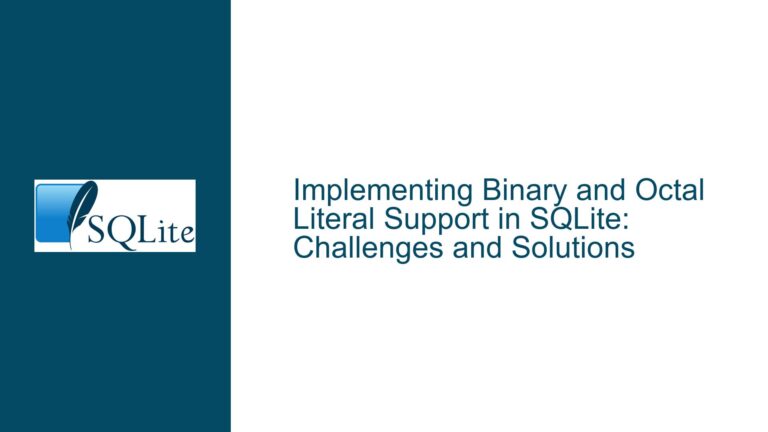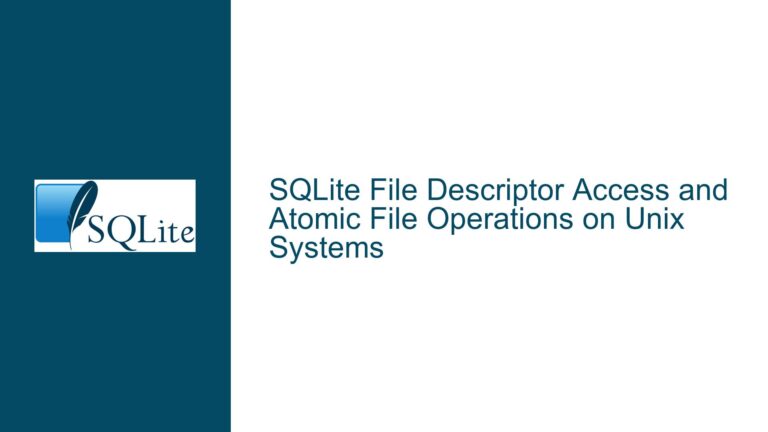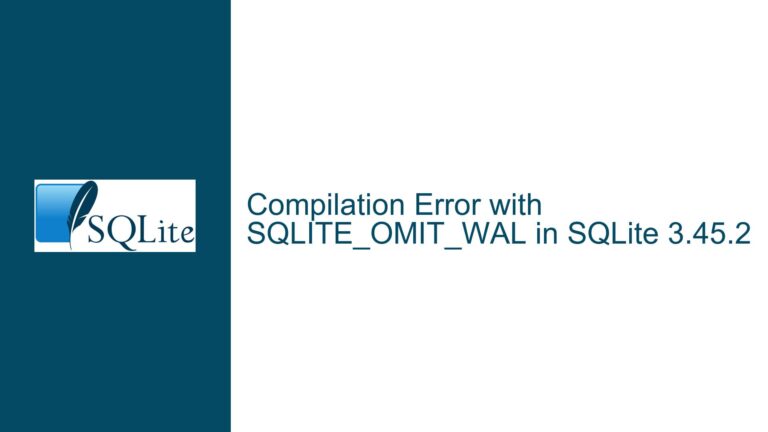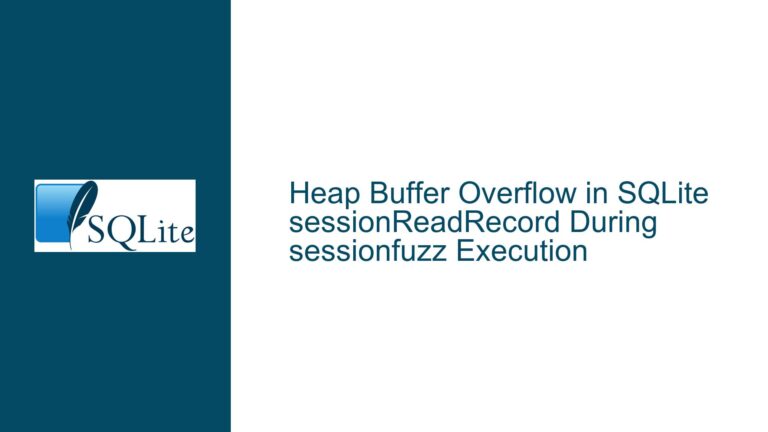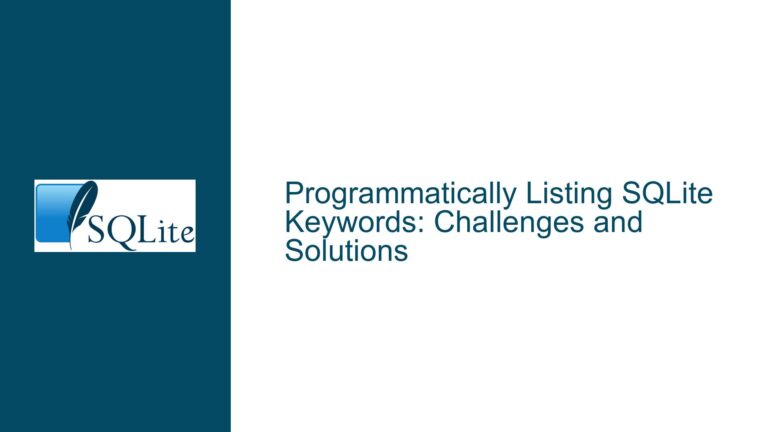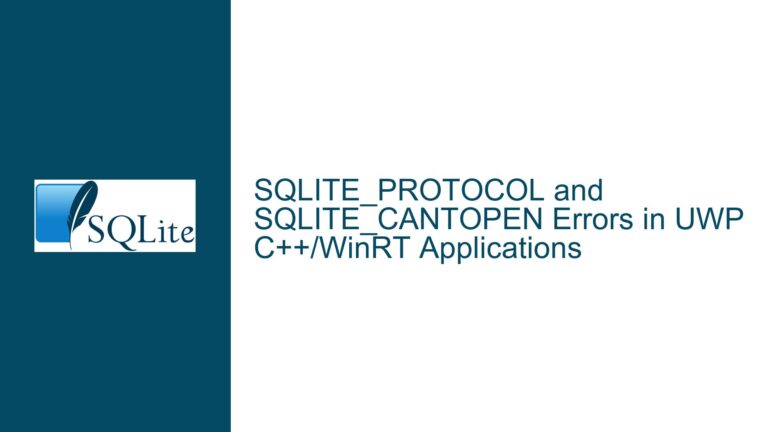SQLite Triggers and Conditional Updates for Timestamp Management
SQLite Trigger Behavior and the Necessity of WHERE Clauses
When working with SQLite triggers, particularly those designed to update timestamp columns during INSERT or UPDATE operations, understanding the role of the WHERE clause is critical. The WHERE clause ensures that the trigger operates on the specific row that triggered it, rather than affecting all rows in the table. This specificity is essential for maintaining data integrity and avoiding unintended side effects.
In the context of the provided example, the triggers insert_process_order and update_process_order are designed to update the Created and Modified columns, respectively, with the current datetime. The WHERE ROWID = new.ROWID clause is used to target the exact row that triggered the operation. Without this clause, the UPDATE statement would apply to all rows in the ProcessingOrders table, leading to incorrect data updates.
The ROWID in SQLite is a unique identifier for each row in a table. For tables without an explicit primary key, ROWID serves as an implicit primary key. When a trigger is fired, the new keyword refers to the new values of the row that triggered the operation. By using WHERE ROWID = new.ROWID, the trigger ensures that only the row being inserted or updated is modified.
However, the use of ROWID assumes that the table is a ROWID table, which is the default in SQLite. If the table has an explicit primary key, it is generally better to use that key in the WHERE clause for clarity and consistency. For example, if the ProcessingOrders table has a primary key column named OrderID, the WHERE clause should be WHERE OrderID = new.OrderID.
Recursive Trigger Firing and Conditional Execution
One of the complexities of SQLite triggers is their potential to fire recursively. When a trigger performs an UPDATE operation on the same table that triggered it, it can cause other triggers to fire, leading to a cascade of updates. This behavior can result in unintended consequences, such as multiple updates to the same row or even infinite loops if not managed properly.
In the example, the insert_process_order trigger updates the Created column, which could potentially cause the update_process_order trigger to fire if the Modified column is also updated. To prevent this, a WHEN clause can be added to the trigger to conditionally execute the UPDATE statement only under specific conditions.
The WHEN clause allows you to specify a condition that must be true for the trigger to execute. For instance, the update_process_order trigger can be modified to include a WHEN clause that checks whether the Modified column has already been updated to the current datetime. This prevents the trigger from firing unnecessarily and ensures that the Modified column is updated only once.
However, the WHEN clause must be carefully constructed to handle edge cases, such as when the Modified column is NULL. In SQLite, comparing NULL with any value results in NULL, which is treated as false in a conditional context. Therefore, the WHEN clause must explicitly handle NULL values to ensure that the trigger behaves as expected.
For example, the WHEN clause WHEN OLD.Modified IS NULL OR OLD.Modified != DATETIME('NOW', 'localtime') ensures that the trigger executes if the Modified column is NULL or if it does not match the current datetime. This approach avoids the pitfalls of NULL comparisons and ensures that the trigger updates the Modified column only when necessary.
Best Practices for Trigger Design and Timestamp Management
To effectively manage timestamps in SQLite using triggers, it is important to follow best practices that ensure data integrity and avoid unintended side effects. These practices include using explicit primary keys in the WHERE clause, preventing recursive trigger firing with WHEN clauses, and handling NULL values appropriately.
When designing triggers for timestamp management, always use the primary key of the table in the WHERE clause rather than relying on ROWID. This approach makes the trigger more readable and maintainable, especially in tables with explicit primary keys. For example, if the ProcessingOrders table has a primary key column named OrderID, the WHERE clause should be WHERE OrderID = new.OrderID.
To prevent recursive trigger firing, use WHEN clauses to conditionally execute the trigger only when necessary. For example, the update_process_order trigger can be modified to include a WHEN clause that checks whether the Modified column has already been updated to the current datetime. This prevents the trigger from firing unnecessarily and ensures that the Modified column is updated only once.
When handling NULL values in WHEN clauses, explicitly check for NULL to avoid unexpected behavior. For example, the WHEN clause WHEN OLD.Modified IS NULL OR OLD.Modified != DATETIME('NOW', 'localtime') ensures that the trigger executes if the Modified column is NULL or if it does not match the current datetime. This approach avoids the pitfalls of NULL comparisons and ensures that the trigger updates the Modified column only when necessary.
In addition to these best practices, consider the following tips for effective trigger design and timestamp management in SQLite:
Use Consistent Datetime Formats: Ensure that all datetime values in the database use a consistent format. This makes it easier to compare datetime values and avoid errors in trigger logic. For example, always use
DATETIME('NOW', 'localtime')to generate datetime values in triggers.Avoid Redundant Updates: Use
WHENclauses to prevent redundant updates to timestamp columns. For example, if theModifiedcolumn is already set to the current datetime, there is no need to update it again. This reduces unnecessary database operations and improves performance.Test Trigger Logic Thoroughly: Before deploying triggers to a production environment, thoroughly test their logic to ensure that they behave as expected. This includes testing edge cases, such as
NULLvalues and recursive trigger firing, to avoid unexpected behavior.Document Trigger Logic: Clearly document the purpose and logic of each trigger to make it easier for other developers to understand and maintain the database schema. This includes documenting the conditions under which the trigger fires and the actions it performs.
Consider Using Stored Procedures: In some cases, it may be more efficient to use stored procedures rather than triggers to manage timestamp updates. Stored procedures provide more control over the logic and can be easier to debug and maintain.
By following these best practices, you can design effective triggers for timestamp management in SQLite that ensure data integrity and avoid unintended side effects. Whether you are updating the Created column during an INSERT operation or the Modified column during an UPDATE operation, careful trigger design and thorough testing are essential for maintaining a reliable and efficient database.
Implementing PRAGMA journal_mode and Database Backup Strategies
In addition to designing effective triggers, it is important to consider the broader context of database management, including transaction handling and backup strategies. SQLite provides several pragmas that can be used to configure database behavior, including PRAGMA journal_mode, which controls how transactions are logged and managed.
The PRAGMA journal_mode pragma can be set to one of several modes, including DELETE, TRUNCATE, PERSIST, MEMORY, WAL, and OFF. Each mode has different implications for performance, durability, and concurrency. For example, the WAL (Write-Ahead Logging) mode provides better concurrency and performance for read-heavy workloads, while the DELETE mode is more suitable for write-heavy workloads.
When using triggers to manage timestamps, it is important to choose a journal_mode that balances performance and durability. For example, if the database is frequently updated by multiple concurrent connections, the WAL mode may provide better performance and concurrency. However, if the database is primarily updated by a single connection, the DELETE mode may be more appropriate.
In addition to configuring journal_mode, it is important to implement a robust backup strategy to protect against data loss. SQLite provides several methods for backing up databases, including the .backup command, the sqlite3_backup API, and the VACUUM INTO command. Each method has different trade-offs in terms of performance, complexity, and flexibility.
For example, the .backup command can be used to create a backup of the entire database to a file, while the sqlite3_backup API provides more control over the backup process, allowing incremental backups and progress monitoring. The VACUUM INTO command can be used to create a compressed backup of the database, reducing storage requirements.
When implementing a backup strategy, consider the following factors:
Frequency of Backups: Determine how often backups should be performed based on the frequency of database updates and the importance of the data. For example, a database that is updated frequently may require daily backups, while a database that is updated infrequently may only require weekly backups.
Storage Location: Store backups in a secure location, such as an external hard drive or cloud storage, to protect against data loss due to hardware failure or other disasters.
Testing Backups: Regularly test backups to ensure that they can be restored successfully. This includes verifying the integrity of the backup file and testing the restore process.
Automating Backups: Use scripts or scheduling tools to automate the backup process, reducing the risk of human error and ensuring that backups are performed consistently.
By configuring PRAGMA journal_mode appropriately and implementing a robust backup strategy, you can ensure that your SQLite database remains reliable and resilient, even in the face of unexpected failures or data corruption. Whether you are managing timestamps with triggers or performing other database operations, these strategies are essential for maintaining a high level of data integrity and availability.
Conclusion
Managing timestamps in SQLite using triggers requires a deep understanding of trigger behavior, conditional execution, and best practices for database design. By using WHERE clauses to target specific rows, preventing recursive trigger firing with WHEN clauses, and handling NULL values appropriately, you can design effective triggers that ensure data integrity and avoid unintended side effects.
In addition to trigger design, it is important to consider the broader context of database management, including transaction handling and backup strategies. By configuring PRAGMA journal_mode appropriately and implementing a robust backup strategy, you can ensure that your SQLite database remains reliable and resilient, even in the face of unexpected failures or data corruption.
Whether you are updating the Created column during an INSERT operation or the Modified column during an UPDATE operation, careful trigger design and thorough testing are essential for maintaining a reliable and efficient database. By following the best practices outlined in this guide, you can effectively manage timestamps in SQLite and ensure the integrity and availability of your data.

